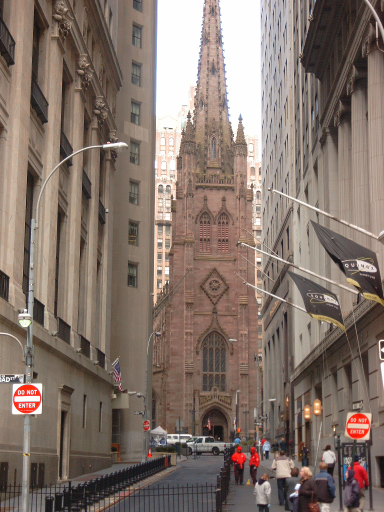Diferenças entre edições de "Wall Street"
(Nova página: {{Editar}} '''New York Stock Exchange, vista do cruzamento de Broad Street com Wall Street]] '''Wall Street''' é...) |
|||
| (14 edições intermédias não estão a ser mostradas.) | |||
| Linha 1: | Linha 1: | ||
| − | + | [[Image:Photos NewYork1 032.jpg|right|thumb|400px|Fachada da [[NYSE|New York Stock Exchange]], vista do cruzamento de Broad Street com Wall Street]] | |
| − | + | [[Image:wall street 1867.jpg|thumb|300px|Vista de Wall Street a partir do cruzamento da Broad Street, 1867.]] | |
| − | + | '''Wall Street''' é uma rua em Manhattan, Nova Yorque, nos EUA. Esta rua estende-se da Broadway à South Street em East River, passando pelo centro histórico do distrito financeiro. A Wall Street foi a primeira sede permanente da [[NYSE|New York Stock Exchange]]; ao longo do tempo ''Wall Street'' passou também a ser o nome do bairro circundante. Também ao longo do tempo, Wall Street tornou-se um sinónimo para a indústria financeira Americana. | |
| − | '''Wall Street''' é uma rua em Manhattan, Nova Yorque, nos EUA. Esta rua | + | |
==História== | ==História== | ||
| − | |||
| − | |||
O nome da rua deriva do facto de que durante o século XVII, Wall Street constituía a fronteira norte de Nova Amsterdam. Nessa altura (1640s), cercas básicas delimitavam propriedades e residências na colónia. Mais tarde, Peter Stuyvesant, parcialmente usando escravos Africanos, construiu uma barreira, ou muro, mais sofisticado, usando madeira e terra. Este muro foi criado, e melhorado ao longo do tempo, para servir como defesa contra ataques de variadas tribos de nativos Americanos, colonos e Britânicos. Em 1685, Wall Street foi estabelecida ao longo deste muro. O muro foi desmantelado pelos Britânicos em 1699. | O nome da rua deriva do facto de que durante o século XVII, Wall Street constituía a fronteira norte de Nova Amsterdam. Nessa altura (1640s), cercas básicas delimitavam propriedades e residências na colónia. Mais tarde, Peter Stuyvesant, parcialmente usando escravos Africanos, construiu uma barreira, ou muro, mais sofisticado, usando madeira e terra. Este muro foi criado, e melhorado ao longo do tempo, para servir como defesa contra ataques de variadas tribos de nativos Americanos, colonos e Britânicos. Em 1685, Wall Street foi estabelecida ao longo deste muro. O muro foi desmantelado pelos Britânicos em 1699. | ||
No final do século XVIII, existia uma árvore, um Plátano, no final da Wall Street, debaixo da qual os [[trader]]s e especuladores se juntavam para transaccionar informalmente entre si. Em 1792, os traders formalizaram a sua associação com o [[Acordo de Buttonwood]]. Esta seria a origem da [[NYSE|New York Stock Exchange]]. | No final do século XVIII, existia uma árvore, um Plátano, no final da Wall Street, debaixo da qual os [[trader]]s e especuladores se juntavam para transaccionar informalmente entre si. Em 1792, os traders formalizaram a sua associação com o [[Acordo de Buttonwood]]. Esta seria a origem da [[NYSE|New York Stock Exchange]]. | ||
| − | + | Em 1889, o relatório original sobre as transacções de acções, o ''Customers' Afternoon Letter'', tornou-se no ''[[The Wall Street Journal]]'', assim designado em referência à própria rua, tendo-se entretanto tornado no diário de negócios mais influente do mundo. Durante muitos anos, o WSJ teve a maior circulação de qualquer diário nos EUA, embora tenha entretanto perdido essa posição para o ''USA Today''. O WSJ é propriedade da News Corp de Rupert Murdoch desde 2007. | |
| − | + | ===Declínio e revitalização=== | |
| + | O distrito financeiro de Manhattan é um dos grandes centros de negócios dos EUA. No final do século XIX e início do século XX, a cultura corporativa de Nova Yorque foi uma fonte de incentivo para a construção de arranha-céus rivalizada apenas por Chicago. | ||
| − | + | [[Image:Wallstreetbmb.jpg|right|thumb|300px|16 de Setembro de 1920: Uma bomba explodiu em frente à sede da JP Morgan no nº 23 de Wall Street. Morreram 38 pessoas e foram feridas 300.]] | |
| − | + | Construído em 1914, o nº 23 de Wall Street é conhecido como a "Casa de Morgan" e foi durante décadas o mais importante endereço na finança Americana, servindo como sede da JP Morgan. Ao meio dia de 16 de Setembro de 1920, uma bomba explodiu em frente ao banco, matando 38 pessoas e ferindo 300. Pouco tempo depois desta bomba ter explodido, foi deixada uma nota de aviso numa caixa de correio da Cedar Street com a Broadway. Embora as teorias sobre as razões e quem esteve por trás do atentado abundem, após 20 anos de investigação, o FBI arquivou o dossier em 1940 sem nunca determinar os culpados. | |
| − | + | ||
| − | + | [[Image:Crowd outside nyse.jpg|left|thumb|251px|Uma multidão junta-se no cruzamento da Wall Street com a Broad Street, após o crash de 1929.]] | |
| − | + | 1929 trouxe o "[[Crash de 1929]]" do mercado accionista, marcando o início da [[Grande depressão]]. Durante esta época, o desenvolvimento do distrito financeiro estagnou. A construção do World Trade Center foi um dos poucos grandes projectos desenvolvidos nos últimos 3 quartos do século XX, e financeiramente não teve o sucesso esperado. | |
| − | [[Image:Crowd outside nyse.jpg|left|thumb|251px| | + | |
| − | 1929 | + | |
| − | + | Ainda assim, algumas firmas de renome compraram espaço do WTC, além deste ter atraído outros negócios relevantes para a sua proximidade. Poder-se-ia argumentar que o WTC alterou o centro do distrito financeiro de Wall Street para o seu complexo. Quando o WTC foi destruído nos ataques de 11 de Setembro de 2001, estes levaram a algum dispersar do negócio de Wall Street, com alguma transferência de negócios para New Jersey, Chicago e Boston. | |
| − | Wall Street | + | Tanto a Wall Street como o distrito financeiro, estão populadas de arranha-céus. Mesmo a perda do World Trade Center, levou a um aumentar do desenvolvimento do distrito financeiro que não se via há décadas. O novo complexo do World Trade Center, centrado no plano "Memory Foundations" de Daniel Liebeskind, está na sua fase inicial de desenvolvimento, e um edifício já foi substituído. A peça central deste novo plano será a Torre da Liberdade (Freedom Tower), com 541 metros de altura. Também estão já a ser construídos novos edifícios residenciais, bem como existem conversões de escritórios para esse uso (também devido à existência de incentivos fiscais nesse sentido). Existem também planos para melhorar o acesso ao distrito financeiro, via uma nova estação de comboios e um novo centro de transportes na Fulton Street. |
| − | Wall Street | + | A cultura de Wall Street é frequentemente criticada como sendo rígida. Este é um estereotipo com décadas de existência, que provém da protecção que o status quo de Wall Street faz aos seus interesses. Uma crítica mais recente, centra-se nos problemas estruturais e falta de desejo de mudança de hábitos bem estabelecidos. O status quo de Wall Street resiste a supervisão e regulação por parte do Governo. Ao mesmo tempo, a cidade de Nova Yorque tem uma reputação de ser uma cidade muito burocrática, o que dificulta ou impossibilita a entrada no distrito financeiro de empreendedores da classe média. |
| − | + | Desde a criação do sistema bancário baseado na [[Reserva federal]], o Banco da Reserva Federal de Nova Yorque, no distrito financeiro de Wall Street, tem sido o ponto onde a [[política monetária]] dos EUA tem sido implementada (ainda que esta seja decidida em Washington, pela Reserva federal). A Reserva Federal de Nova Yorque possui ainda um cofre 25 metros debaixo do solo, este depositório é o maior do mundo, maior ainda que o Fort Knox. | |
| − | == | + | ==Edifícios== |
| − | [[Image:Federal Hall NYC1.jpg|thumb|right|250px|Federal Hall | + | [[Image:Federal Hall NYC1.jpg|thumb|right|250px|Federal Hall em Wall Street.]] |
| − | Wall Street | + | A arquitectura de Wall Street tem as suas raízes na idade dourada (anos 20), embora existam algumas influências de art deco no bairro. Marcos importantes na Wall Street incluem a Federal Hall, o nº14 de Wall Street ([[Bankers Trust]]), o nº40 de Wall Street (Edifício Trump) e a [[NYSE|New York Stock Exchange]]. |
| − | == | + | ==Personalidades== |
| − | + | Ao longo dos anos, muitas pessoas associadas com Wall Street tornaram-se famosas. Embora as suas reputações sejam normalmente limitadas aos membros das comunidades corretoras e da banca, alguns ganharam fama nacional e internacional. Uns mereceram a sua fama pelas suas estratégias de investimento e financiamento, ou pelas suas capacidades legais e regulatórias, enquanto outros são conhecidos pela sua ganância. | |
| − | + | Uma das representações icónicas da prosperidade do mercado, é a escultura da investida do touro (''[[Charging Bull]]'') de Arturo Di Modica. Esta representa uma economia em [[bull market]], a escultura foi originalmente colocada em frente à [[NYSE|New York Stock Exchange]], mas subsequentemente movida para a sua localização actual no Bowling Green. | |
| − | == | + | ==Influência cultural== |
| − | ===Wall Street | + | ===Wall Street versus Main Street=== |
| − | [[Image:Wall Street & Broadway.JPG|thumb|right | + | [[Image:Wall Street & Broadway.JPG|thumb|right]] |
| − | + | Quando se contrasta a "Main Street" com o termo "Wall Street", isto geralmente refere-se aos grandes negócios financeiros versus os negócios industriais, pequenos e médios, ou a classe trabalhadora. | |
| − | + | ||
| − | === | + | ===Percepção=== |
| − | [[Image:Trinitychurch.png|thumb|left|Trinity church | + | [[Image:Trinitychurch.png|thumb|left|Trinity church vista de Wall Street.]] |
| − | + | Os arranha céus mais antigos, eram muitas vezes construídos com fachadas elaboradas; esse tipo de estética não tem sido comum na arquitectura corporativa nas últimas décadas, o WTC construído nos anos 70, era simples e utilitário por comparação. As torres do WTC eram frequentemente criticadas por parecerem simplesmente duas grandes caixas, apesar da sua altura impressionante. | |
| − | Wall Street, | + | A Wall Street, mais que qualquer outra coisa, representa o poder financeiro e económico. Para os Americanos, Wall Street pode por vezes representar elitismo, políticas de poder e capitalismo selvagem, mas também gera sentimentos de orgulho acerca da economia de mercado. Wall Street tornou-se no símbolo de um país e sistema económico que muitos Americanos vêem como se tendo desenvolvido não através de colonialismo e exploração, mas sim através de comércio, capitalismo e inovação. |
| − | == | + | ==Ver também== |
| − | *[[ | + | *[[Crash de 1929]] |
| − | + | *[[Grande depressão]] | |
| − | + | ||
| − | + | ||
| − | + | ||
| − | * | + | |
| − | == | + | ==Referências== |
| − | + | ||
| − | + | ||
| − | + | ||
| − | + | ||
| − | + | ||
| − | + | ||
| − | + | ||
| − | + | ||
| − | + | ||
| − | + | ||
| − | + | ||
| − | + | ||
| − | + | ||
| − | + | ||
| − | + | ||
| − | + | ||
| − | + | ||
| − | + | ||
| − | + | ||
| − | + | ||
| − | + | ||
| − | + | ||
| − | + | ||
| − | + | ||
| − | + | ||
| − | + | ||
| − | + | ||
| − | + | ||
| − | + | ||
| − | + | ||
| − | + | ||
| − | + | ||
| − | + | ||
| − | + | ||
| − | + | ||
| − | + | ||
| − | + | ||
| − | + | ||
* Atwood, Albert W. and Erickson, Erling A. "Morgan, John Pierpont, (Apr. 17, 1837 - Mar. 31, 1913)," in ''Dictionary of American Biography, Volume 7'' (1934) | * Atwood, Albert W. and Erickson, Erling A. "Morgan, John Pierpont, (Apr. 17, 1837 - Mar. 31, 1913)," in ''Dictionary of American Biography, Volume 7'' (1934) | ||
* Carosso, Vincent P. ''The Morgans: Private International Bankers, 1854-1913.'' Harvard U. Press, 1987. 888 pp. ISBN 978-0674587298 | * Carosso, Vincent P. ''The Morgans: Private International Bankers, 1854-1913.'' Harvard U. Press, 1987. 888 pp. ISBN 978-0674587298 | ||
| Linha 110: | Linha 62: | ||
* Morris, Charles R. ''The Tycoons: How Andrew Carnegie, John D. Rockefeller, Jay Gould, and J. P. Morgan Invented the American Supereconomy'' (2005) ISBN 978-0805081343 | * Morris, Charles R. ''The Tycoons: How Andrew Carnegie, John D. Rockefeller, Jay Gould, and J. P. Morgan Invented the American Supereconomy'' (2005) ISBN 978-0805081343 | ||
* Perkins, Edwin J. ''Wall Street to Main Street: Charles Merrill and Middle-class Investors'' (1999) | * Perkins, Edwin J. ''Wall Street to Main Street: Charles Merrill and Middle-class Investors'' (1999) | ||
| − | * | + | * Robert Sobel ''The Big Board: A History of the New York Stock Market'' (1962) |
| − | * | + | * Robert Sobel ''The Great Bull Market: Wall Street in the 1920s'' (1968) |
| − | * | + | * Robert Sobel ''Inside Wall Street: Continuity & Change in the Financial District'' (1977) |
* Strouse, Jean. ''Morgan: American Financier.'' Random House, 1999. 796 pp. ISBN 978-0679462750 | * Strouse, Jean. ''Morgan: American Financier.'' Random House, 1999. 796 pp. ISBN 978-0679462750 | ||
| − | == | + | ==Links relevantes== |
| − | + | ||
*[http://www.pbs.org/wgbh/pages/frontline/shows/wallstreet/ Frontline: The Wall Street Fix] - PBS | *[http://www.pbs.org/wgbh/pages/frontline/shows/wallstreet/ Frontline: The Wall Street Fix] - PBS | ||
| − | |||
| − | |||
| − | |||
| − | |||
| − | [[ | + | [[Categoria:Conceitos]] |
| − | + | ||
Edição atual desde as 08h41min de 11 de janeiro de 2010
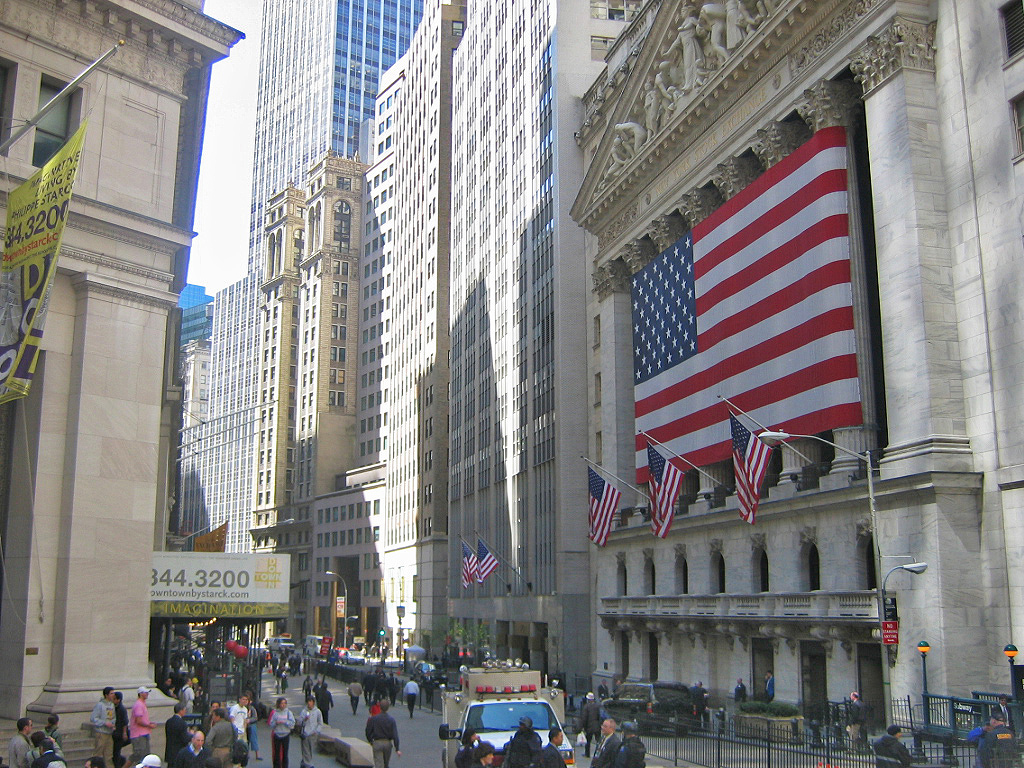
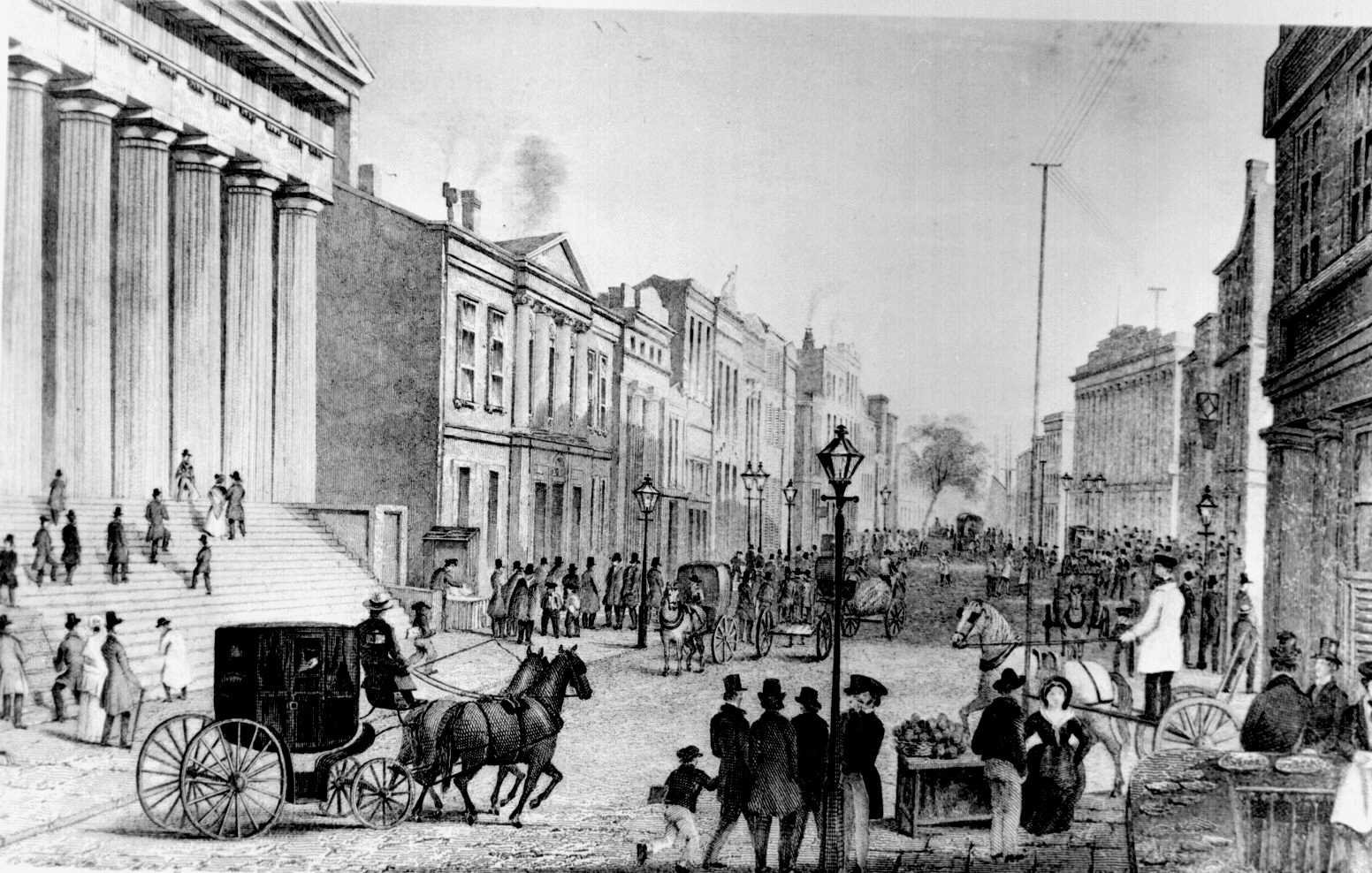 Wall Street é uma rua em Manhattan, Nova Yorque, nos EUA. Esta rua estende-se da Broadway à South Street em East River, passando pelo centro histórico do distrito financeiro. A Wall Street foi a primeira sede permanente da New York Stock Exchange; ao longo do tempo Wall Street passou também a ser o nome do bairro circundante. Também ao longo do tempo, Wall Street tornou-se um sinónimo para a indústria financeira Americana.
Wall Street é uma rua em Manhattan, Nova Yorque, nos EUA. Esta rua estende-se da Broadway à South Street em East River, passando pelo centro histórico do distrito financeiro. A Wall Street foi a primeira sede permanente da New York Stock Exchange; ao longo do tempo Wall Street passou também a ser o nome do bairro circundante. Também ao longo do tempo, Wall Street tornou-se um sinónimo para a indústria financeira Americana.
Índice
História
O nome da rua deriva do facto de que durante o século XVII, Wall Street constituía a fronteira norte de Nova Amsterdam. Nessa altura (1640s), cercas básicas delimitavam propriedades e residências na colónia. Mais tarde, Peter Stuyvesant, parcialmente usando escravos Africanos, construiu uma barreira, ou muro, mais sofisticado, usando madeira e terra. Este muro foi criado, e melhorado ao longo do tempo, para servir como defesa contra ataques de variadas tribos de nativos Americanos, colonos e Britânicos. Em 1685, Wall Street foi estabelecida ao longo deste muro. O muro foi desmantelado pelos Britânicos em 1699.
No final do século XVIII, existia uma árvore, um Plátano, no final da Wall Street, debaixo da qual os traders e especuladores se juntavam para transaccionar informalmente entre si. Em 1792, os traders formalizaram a sua associação com o Acordo de Buttonwood. Esta seria a origem da New York Stock Exchange.
Em 1889, o relatório original sobre as transacções de acções, o Customers' Afternoon Letter, tornou-se no The Wall Street Journal, assim designado em referência à própria rua, tendo-se entretanto tornado no diário de negócios mais influente do mundo. Durante muitos anos, o WSJ teve a maior circulação de qualquer diário nos EUA, embora tenha entretanto perdido essa posição para o USA Today. O WSJ é propriedade da News Corp de Rupert Murdoch desde 2007.
Declínio e revitalização
O distrito financeiro de Manhattan é um dos grandes centros de negócios dos EUA. No final do século XIX e início do século XX, a cultura corporativa de Nova Yorque foi uma fonte de incentivo para a construção de arranha-céus rivalizada apenas por Chicago.
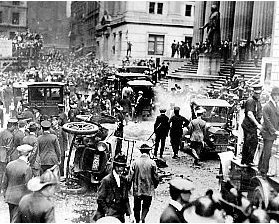 Construído em 1914, o nº 23 de Wall Street é conhecido como a "Casa de Morgan" e foi durante décadas o mais importante endereço na finança Americana, servindo como sede da JP Morgan. Ao meio dia de 16 de Setembro de 1920, uma bomba explodiu em frente ao banco, matando 38 pessoas e ferindo 300. Pouco tempo depois desta bomba ter explodido, foi deixada uma nota de aviso numa caixa de correio da Cedar Street com a Broadway. Embora as teorias sobre as razões e quem esteve por trás do atentado abundem, após 20 anos de investigação, o FBI arquivou o dossier em 1940 sem nunca determinar os culpados.
Construído em 1914, o nº 23 de Wall Street é conhecido como a "Casa de Morgan" e foi durante décadas o mais importante endereço na finança Americana, servindo como sede da JP Morgan. Ao meio dia de 16 de Setembro de 1920, uma bomba explodiu em frente ao banco, matando 38 pessoas e ferindo 300. Pouco tempo depois desta bomba ter explodido, foi deixada uma nota de aviso numa caixa de correio da Cedar Street com a Broadway. Embora as teorias sobre as razões e quem esteve por trás do atentado abundem, após 20 anos de investigação, o FBI arquivou o dossier em 1940 sem nunca determinar os culpados.
 1929 trouxe o "Crash de 1929" do mercado accionista, marcando o início da Grande depressão. Durante esta época, o desenvolvimento do distrito financeiro estagnou. A construção do World Trade Center foi um dos poucos grandes projectos desenvolvidos nos últimos 3 quartos do século XX, e financeiramente não teve o sucesso esperado.
1929 trouxe o "Crash de 1929" do mercado accionista, marcando o início da Grande depressão. Durante esta época, o desenvolvimento do distrito financeiro estagnou. A construção do World Trade Center foi um dos poucos grandes projectos desenvolvidos nos últimos 3 quartos do século XX, e financeiramente não teve o sucesso esperado.
Ainda assim, algumas firmas de renome compraram espaço do WTC, além deste ter atraído outros negócios relevantes para a sua proximidade. Poder-se-ia argumentar que o WTC alterou o centro do distrito financeiro de Wall Street para o seu complexo. Quando o WTC foi destruído nos ataques de 11 de Setembro de 2001, estes levaram a algum dispersar do negócio de Wall Street, com alguma transferência de negócios para New Jersey, Chicago e Boston.
Tanto a Wall Street como o distrito financeiro, estão populadas de arranha-céus. Mesmo a perda do World Trade Center, levou a um aumentar do desenvolvimento do distrito financeiro que não se via há décadas. O novo complexo do World Trade Center, centrado no plano "Memory Foundations" de Daniel Liebeskind, está na sua fase inicial de desenvolvimento, e um edifício já foi substituído. A peça central deste novo plano será a Torre da Liberdade (Freedom Tower), com 541 metros de altura. Também estão já a ser construídos novos edifícios residenciais, bem como existem conversões de escritórios para esse uso (também devido à existência de incentivos fiscais nesse sentido). Existem também planos para melhorar o acesso ao distrito financeiro, via uma nova estação de comboios e um novo centro de transportes na Fulton Street.
A cultura de Wall Street é frequentemente criticada como sendo rígida. Este é um estereotipo com décadas de existência, que provém da protecção que o status quo de Wall Street faz aos seus interesses. Uma crítica mais recente, centra-se nos problemas estruturais e falta de desejo de mudança de hábitos bem estabelecidos. O status quo de Wall Street resiste a supervisão e regulação por parte do Governo. Ao mesmo tempo, a cidade de Nova Yorque tem uma reputação de ser uma cidade muito burocrática, o que dificulta ou impossibilita a entrada no distrito financeiro de empreendedores da classe média.
Desde a criação do sistema bancário baseado na Reserva federal, o Banco da Reserva Federal de Nova Yorque, no distrito financeiro de Wall Street, tem sido o ponto onde a política monetária dos EUA tem sido implementada (ainda que esta seja decidida em Washington, pela Reserva federal). A Reserva Federal de Nova Yorque possui ainda um cofre 25 metros debaixo do solo, este depositório é o maior do mundo, maior ainda que o Fort Knox.
Edifícios
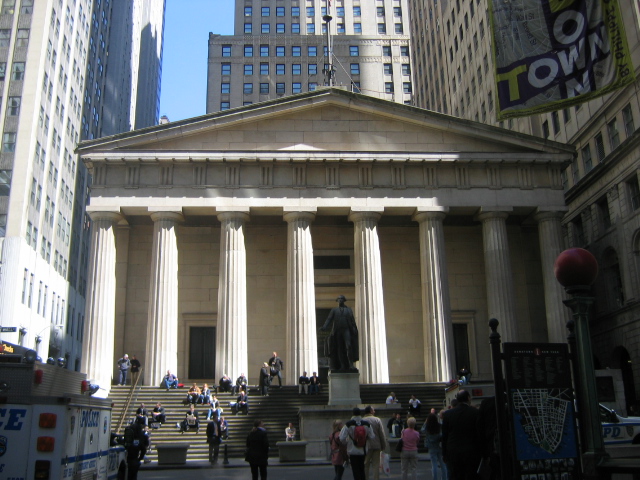 A arquitectura de Wall Street tem as suas raízes na idade dourada (anos 20), embora existam algumas influências de art deco no bairro. Marcos importantes na Wall Street incluem a Federal Hall, o nº14 de Wall Street (Bankers Trust), o nº40 de Wall Street (Edifício Trump) e a New York Stock Exchange.
A arquitectura de Wall Street tem as suas raízes na idade dourada (anos 20), embora existam algumas influências de art deco no bairro. Marcos importantes na Wall Street incluem a Federal Hall, o nº14 de Wall Street (Bankers Trust), o nº40 de Wall Street (Edifício Trump) e a New York Stock Exchange.
Personalidades
Ao longo dos anos, muitas pessoas associadas com Wall Street tornaram-se famosas. Embora as suas reputações sejam normalmente limitadas aos membros das comunidades corretoras e da banca, alguns ganharam fama nacional e internacional. Uns mereceram a sua fama pelas suas estratégias de investimento e financiamento, ou pelas suas capacidades legais e regulatórias, enquanto outros são conhecidos pela sua ganância.
Uma das representações icónicas da prosperidade do mercado, é a escultura da investida do touro (Charging Bull) de Arturo Di Modica. Esta representa uma economia em bull market, a escultura foi originalmente colocada em frente à New York Stock Exchange, mas subsequentemente movida para a sua localização actual no Bowling Green.
Influência cultural
Wall Street versus Main Street
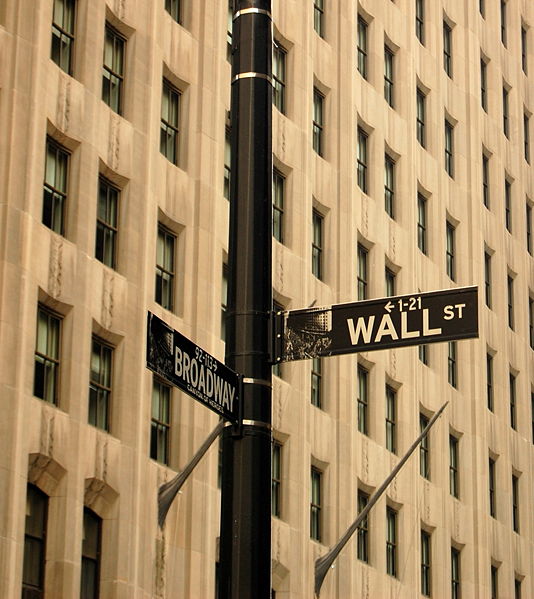
Percepção
Os arranha céus mais antigos, eram muitas vezes construídos com fachadas elaboradas; esse tipo de estética não tem sido comum na arquitectura corporativa nas últimas décadas, o WTC construído nos anos 70, era simples e utilitário por comparação. As torres do WTC eram frequentemente criticadas por parecerem simplesmente duas grandes caixas, apesar da sua altura impressionante.
A Wall Street, mais que qualquer outra coisa, representa o poder financeiro e económico. Para os Americanos, Wall Street pode por vezes representar elitismo, políticas de poder e capitalismo selvagem, mas também gera sentimentos de orgulho acerca da economia de mercado. Wall Street tornou-se no símbolo de um país e sistema económico que muitos Americanos vêem como se tendo desenvolvido não através de colonialismo e exploração, mas sim através de comércio, capitalismo e inovação.
Ver também
Referências
- Atwood, Albert W. and Erickson, Erling A. "Morgan, John Pierpont, (Apr. 17, 1837 - Mar. 31, 1913)," in Dictionary of American Biography, Volume 7 (1934)
- Carosso, Vincent P. The Morgans: Private International Bankers, 1854-1913. Harvard U. Press, 1987. 888 pp. ISBN 978-0674587298
- Carosso, Vincent P. Investment Banking in America: A History Harvard University Press (1970)
- Chernow, Ron. The House of Morgan: An American Banking Dynasty and the Rise of Modern Finance, (2001) ISBN 0-8021-3829-2
- Fraser, Steve. Every Man a Speculator: A History of Wall Street in American Life HarperCollins (2005)
- Geisst; Charles R. Wall Street: A History from Its Beginnings to the Fall of Enron. Oxford University Press. 2004. online edition
- John Moody; The Masters of Capital: A Chronicle of Wall Street Yale University Press, (1921) online edition
- Morris, Charles R. The Tycoons: How Andrew Carnegie, John D. Rockefeller, Jay Gould, and J. P. Morgan Invented the American Supereconomy (2005) ISBN 978-0805081343
- Perkins, Edwin J. Wall Street to Main Street: Charles Merrill and Middle-class Investors (1999)
- Robert Sobel The Big Board: A History of the New York Stock Market (1962)
- Robert Sobel The Great Bull Market: Wall Street in the 1920s (1968)
- Robert Sobel Inside Wall Street: Continuity & Change in the Financial District (1977)
- Strouse, Jean. Morgan: American Financier. Random House, 1999. 796 pp. ISBN 978-0679462750
